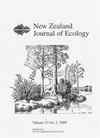Analysis of spatiotemporal patterns of home range use and habitat selection to inform management of feral pigs on Auckland Island
IF 1.4
3区 环境科学与生态学
Q3 ECOLOGY
引用次数: 4
Abstract
: Feral pigs ( Sus scrofa ) were introduced to Auckland Island in subantarctic New Zealand in 1807. They established and became invasive, subsequently causing substantial unwanted impacts on native biodiversity. Understanding pig movement behaviour and habitat selection can lead to focused, efficient, and effective management efforts, especially during initial knockdown of the population. Here we used location data from ARGOS telemetry collars deployed on 15 Auckland Island pigs from 2007 to 2008 to estimate seasonal home-range sizes and habitat selection. The annual home-range sizes of pigs ranged from 1.26 to 36.4 km 2 , with a mean of 14.1 km 2 (SD = 11.3 km 2 ). The variation in home-range sizes between winter and summer was generally low. We found that the pig population selected areas of their home ranges that were on average closer to the coast (though this was not necessarily selection for beaches or strandlines per se) during the spring and summer months. Pigs also selected areas closer to the coast in winter, albeit with weaker strength of selection than in spring and summer. We had insufficient data to differentiate between different coastal habitats (i.e. cliffs versus beaches and strandlines). We also found that pigs showed annual selection for tussock, hills with north-facing aspects, and rivers and streams. They avoided areas of bog-swamp and forest-scrub. Importantly, we do not know what food resources or other factors were driving habitat selection. Our results highlight areas selected by pigs that could be targeted for initial knockdown; however, staff will have to search all habitats on the island to achieve rapid eradication or a protracted mop-up of survivors. Simply targeting key accessible areas like strandlines and coastal forests will not achieve eradication. Based on these home-range sizes, eradication would require a hunter path spacing of no more than 1.4 km to ensure every pig home range was searched at least once.分析奥克兰岛野猪的家域利用和栖息地选择的时空模式,为管理提供信息
野猪(Sus scrofa)于1807年被引入新西兰亚南极的奥克兰岛。它们定居下来并成为入侵物种,随后对本地生物多样性造成了严重的有害影响。了解猪的运动行为和栖息地选择可以导致集中、高效和有效的管理工作,特别是在种群的初始击倒期间。在这里,我们使用了2007年至2008年在15头奥克兰岛猪上部署的ARGOS遥测项圈的位置数据,以估计季节性的家庭范围大小和栖息地选择。猪的年家庭活动范围为1.26 ~ 36.4 km2,平均14.1 km2 (SD = 11.3 km2)。在冬季和夏季之间,家庭范围大小的变化通常很低。我们发现,在春季和夏季,猪群选择了平均更靠近海岸的家园区域(尽管这并不一定是对海滩或海岸线本身的选择)。猪在冬季也会选择靠近海岸的地区,尽管选择的强度比春季和夏季弱。我们没有足够的数据来区分不同的海岸栖息地(即悬崖、海滩和海岸线)。我们还发现,猪对草丛、朝北的山丘、河流和溪流表现出年度选择。他们避开了沼泽和森林灌木丛地区。重要的是,我们不知道是什么食物资源或其他因素推动了栖息地的选择。我们的结果突出了猪选择的可能被初始敲除的区域;然而,工作人员必须搜索岛上的所有栖息地,以实现迅速消灭或长期清除幸存者。仅以海岸线和沿海森林等主要可达地区为目标是无法实现根除的。基于这些家庭范围的大小,根除将需要猎人路径间距不超过1.4公里,以确保每头猪的家庭范围至少被搜索一次。
本文章由计算机程序翻译,如有差异,请以英文原文为准。
求助全文
约1分钟内获得全文
求助全文
来源期刊

New Zealand Journal of Ecology
环境科学-生态学
CiteScore
3.00
自引率
12.50%
发文量
35
审稿时长
>36 weeks
期刊介绍:
The New Zealand Journal of Ecology is a biannual peer-reviewed journal publishing ecological research relevant to New Zealand/Aotearoa and the South Pacific. It has been published since 1952 (as a 1952 issue of New Zealand Science Review and as the Proceedings of the New Zealand Ecological Society until 1977). The Journal is published by the New Zealand Ecological Society (Inc.), and is covered by Current Contents/Agriculture, Biology and Environmental Science, GEOBASE, and Geo Abstracts.
 求助内容:
求助内容: 应助结果提醒方式:
应助结果提醒方式:


